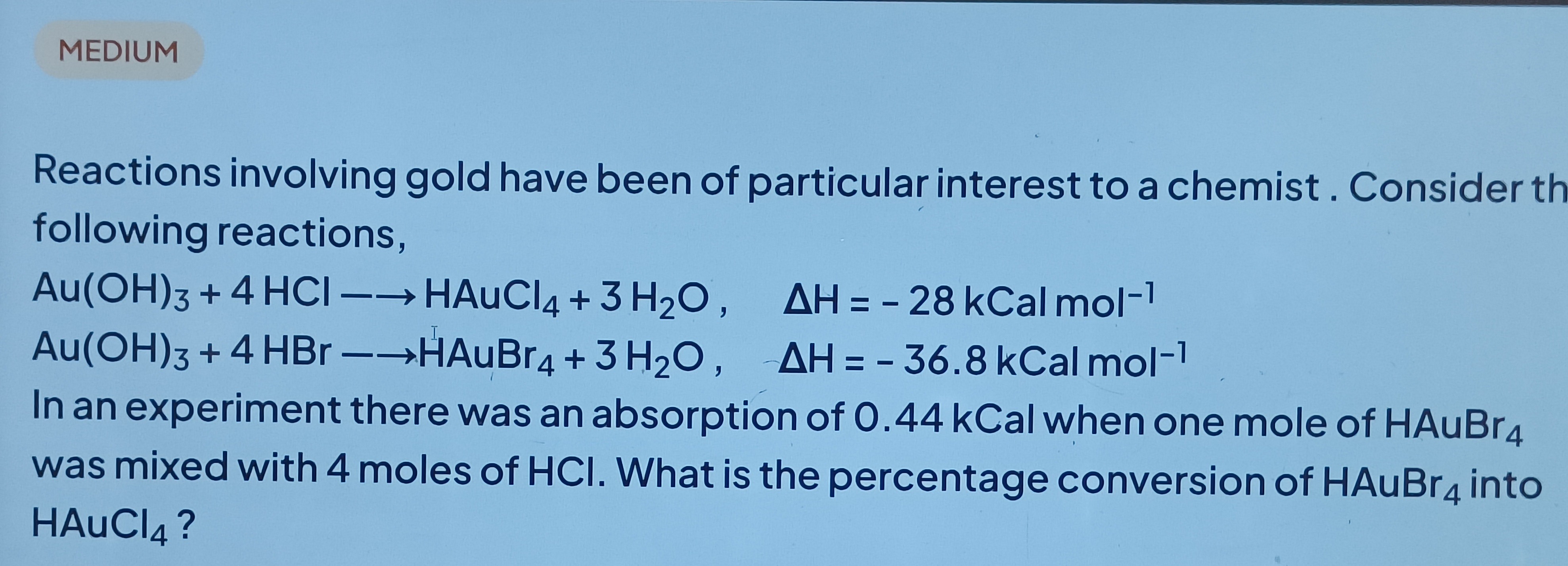Question
Question: Reactions involving gold have been of particular interest to a chemist. Consider the following react...
Reactions involving gold have been of particular interest to a chemist. Consider the following reactions, Au(OH)3+4HCl⟶HAuCl4+3H2O,ΔH=−28 kCal mol−1 Au(OH)3+4HBr⟶HAuBr4+3H2O,ΔH=−36.8 kCal mol−1 In an experiment there was an absorption of 0.44 kCal when one mole of HAuBr4 was mixed with 4 moles of HCl. What is the percentage conversion of HAuBr4 into HAuCl4?

5%
6%
7%
8%
5%
Solution
The enthalpy change for the conversion of HAuBr4 to HAuCl4 is determined using Hess's Law. Given reactions:
- Au(OH)3+4HCl⟶HAuCl4+3H2O,ΔH1=−28 kCal mol−1
- Au(OH)3+4HBr⟶HAuBr4+3H2O,ΔH2=−36.8 kCal mol−1
To find the enthalpy change for the reaction HAuBr4+4HCl⟶HAuCl4+4HBr, we manipulate the given reactions:
- Keep reaction (1) as is.
- Reverse reaction (2) and change its enthalpy sign: HAuBr4+3H2O⟶Au(OH)3+4HBr,ΔH−2=−(−36.8)=+36.8 kCal mol−1
Adding reaction (1) and the reversed reaction (2): Au(OH)3+4HCl⟶HAuCl4+3H2O HAuBr4+3H2O⟶Au(OH)3+4HBr
HAuBr4+4HCl⟶HAuCl4+4HBr
The enthalpy change for this conversion reaction is: ΔHconv=ΔH1+ΔH−2=−28 kCal mol−1+36.8 kCal mol−1=+8.8 kCal mol−1
This means that for the complete conversion of 1 mole of HAuBr4 to HAuCl4, 8.8 kCal of heat is absorbed. In the experiment, 0.44 kCal of heat was absorbed when 1 mole of HAuBr4 was mixed with 4 moles of HCl.
The percentage conversion is calculated as: \text{Percentage Conversion} = \frac{\text{Observed heat absorbed}}{\text{Theoretical heat absorbed for 100% conversion}} \times 100 Percentage Conversion=8.8 kCal0.44 kCal×100 Percentage Conversion=201×100=5%
